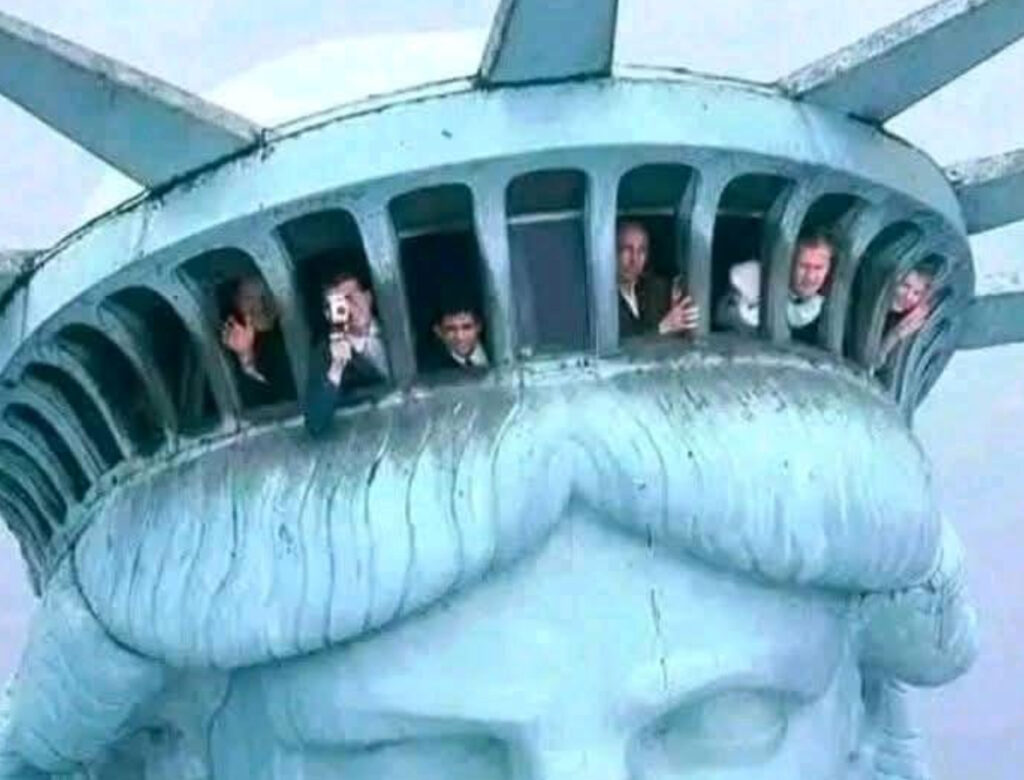There was a time when visiting a national monument meant more than snapping a photo or scanning a QR code. It meant effort. It meant discomfort. It meant—if you were lucky—adventure.
During the 1970s and 1980s, the Statue of Liberty wasn’t just something to admire from a ferry or photograph from Battery Park. It was something you could enter. Something you could climb.
And for those who made the journey up 162 narrow, winding steps to Lady Liberty’s crown, it was an experience equal parts terrifying and exhilarating.
In that era—before 9/11, before rigid park regulations, before digital queuing systems—visiting the Statue of Liberty was less like going to a museum and more like stepping into the skeleton of a living giant. It was hot. It was loud. It was precarious. And it was unforgettable.
This is the story of that lost moment in American tourism: when Lady Liberty wasn’t just a symbol, but a hands-on adventure.
How It Worked: Just Show Up and Start Climbing
No Reservations, No Red Tape
Back then, there was no need to book tickets six months in advance. You didn’t have to pass through TSA-style screening. You didn’t need a crown access permit or a signed waiver. You just bought a ticket at the booth and got in line.
Visitors took the ferry from Battery Park, walked into the pedestal, and started climbing.
- There were no age limits. Families brought toddlers. Seniors climbed with canes.
- There were no guides. You were left to your own rhythm, your own pace.
- There was no fanfare. No signs warned you how difficult it might be. The climb just began.
The entire ascent to the crown could take anywhere from 30 minutes to two hours depending on foot traffic. And while the stairs were narrow and the air thin, most climbers were too mesmerized to notice the discomfort.
“It was a rite of passage. You didn’t just visit the statue. You went inside her. You looked out through her eyes.”
—Jenna L., visitor in 1980
The Climb: Narrow, Dizzying, and Completely Unregulated
A Staircase Like No Other
Inside Lady Liberty’s iron ribs, a spiral staircase just 19 inches wide coiled upward. You had to walk single-file, turning with the curvature of her structure. There were sections with no handrails. Others with uneven footing.
In high summer, the temperature soared. In winter, wind sliced through the copper shell. You could feel the whole statue sway ever so slightly on breezy days—an engineered motion that didn’t feel reassuring when you were halfway up, suspended in a cage of metal.
The structure creaked. The copper groaned.
And yet, there was magic in the madness. You were inside Gustave Eiffel’s skeleton, climbing through the ribs and vertebrae of a global icon.
- Rivets and iron beams surrounded you, as though you were inside a cathedral of industry.
- Each step brought you closer to Liberty’s thoughts, her gaze, her symbolism.
“Every stair made it more real. You forgot she was a monument. You felt like she was alive.”
—Tom C., 1976 visitor
The Crown: A View for the Brave
Seven Tiny Windows, Infinite Meaning
After the final twisting flight, visitors emerged into the crown chamber, a cramped metal dome with seven narrow windows looking out over New York Harbor.
- The space was smaller than most bathrooms, able to fit maybe 10 people at a time.
- The copper walls were uninsulated, causing intense heat or cold depending on the season.
- The view was both beautiful and eerie—filtered through curved glass, framed by the edges of her spiked crown.
There was no timed exit. No usher reminding you to move along. You stayed as long as you could stand the heat, the claustrophobia, or the weight of history.
Parents lifted children to the windows. Couples kissed. Some sat in silence.
“You felt like you were seeing the city from her perspective. Watching, not judging. Just protecting.”
—Sarah M., climbed in 1985
The Interior: An Engineering Masterpiece Few Saw
Eiffel’s Hidden Work of Genius
Most modern visitors never glimpse the internal structure that holds Lady Liberty together. But climbers in the 1970s and 1980s did. They walked through a forest of iron beams—Eiffel’s lesser-known masterpiece.
- The copper shell is just 3/32 of an inch thick—less than the width of two pennies.
- The iron skeleton and copper skin are separate systems, designed to allow movement in the wind.
- At certain points, you could see daylight filtering through pinholes in the copper.
Some visitors carved initials into hidden beams. Others dropped coins into unreachable crevices. It felt like a sacred, secret place.
The Decline: Why the Experience Ended
Too Much Wear, Too Many Risks
By the mid-1980s, the crown climb had become too popular—and too dangerous. Decades of tourism had worn down the stairs, degraded the structure, and created serious safety concerns:
- The staircase was a firetrap: one way up, one way down.
- There was no evacuation route in an emergency.
- Weight and vibration from millions of feet had taken a toll.
In 1984, the statue closed for renovations. When it reopened in 1986, the crown remained accessible—but with new limitations.
The 9/11 Effect: A New Era of Restrictions
After the 2001 terrorist attacks, the Statue of Liberty was completely closed to the public. When it reopened in stages between 2004 and 2009, everything had changed:
- Visitors had to pass through airport-style security.
- Crown access was limited to 240 people per day.
- Tickets had to be reserved months in advance.
- The staircase was modified with safety enhancements and railings.
The sense of spontaneity and intimacy was gone. The climb remained—but not the adventure.
Nostalgia and Legacy: Remembering the Climb
The Memory Lingers
For those who climbed during the ’70s and ’80s, the experience remains vivid:
- The smell of old metal and sweat.
- The creaking of the staircase in the wind.
- The thump of your heart as you reached the top.
It wasn’t convenient. It wasn’t comfortable. And that’s exactly why it’s remembered.
“You earned it. You felt connected to her. Not like a tourist, but like a guest.”
—David H., who climbed in 1979
Could It Ever Return?
Technology May Offer a Middle Ground
While a full return to unrestricted crown access is unlikely, VR and digital reconstructions may offer new ways to recreate the climb:
- Virtual reality headsets could simulate the experience in full detail.
- Holographic museum exhibits could walk visitors through the staircase.
- Guided expert tours may allow special access for small groups.
Still, the rawness—the heat, the danger, the thrill—can’t be fully digitized.
Impression: A Moment Lost, But Not Forgotten
The Statue of Liberty will always stand. Her crown will always gleam. But the era when you could simply walk into her body, climb her bones, and look through her eyes—that era is gone.
What remains is a memory. A memory of sweat, metal, movement, and pride. Of seeing New York through copper-rimmed windows. Of touching history not with your hands, but with your whole body.
That memory belongs to the climbers of the 1970s and 1980s—and to the stories they keep alive.
No comments yet.







